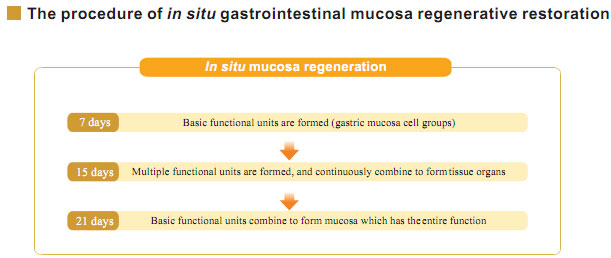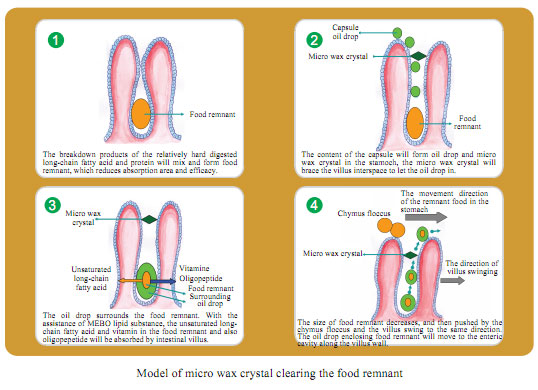Part Four: Research about the Effects and Mechanisms
作者:Xu Rongxiang 出版社:CHINA SOCIAL SCIENCES PRESS 发行日期:2009 September1) Mechanisms of Renewing Aged Gastrointestinal Mucosa
Most of persons who are over 35 years old have the following experiences: listless, poor digestion, more frequent gastrointestinal complaints, poor immunity, and other diseases. The main reasons include: the gastrointestinal organs are aging; the proliferation activity of the stem cells in the gastrointestinal mucosa decreases, which can not meet the requirements for mucosa renewal, and nutrition absorbed is insufficient.
The medical features of aged gastrointestinal organs:
Many medical researches prove that the aging of human body begins from the aging of gastrointestinal mucosa, and the process is much faster and occurs earlier than that of the other organs.
The Atrophy of Gastric Mucosa: gastric mucosa atrophy occurs when people are over 30 years old. It starts with small area, which appears only above the gastric angle. While after age of 50, nearly half of the gastric mucosa shows atrophy.
Intestinal metaplasia of gastric mucosa : this is also one signal of gastric mucosa atrophy, namely: the gastric mucosa becomes similar to intestinal tract mucosa, which will lead to declining of the digestion and secretion function. The ratio of intestinal metaplasia reaches to 50% when persons are 40, to 60% when 50, and 80% when 60 years old.
The decrease of the amount of digestive secretion such as gastric acid and pepsin: 20% of persons around 50 years old can not secrete enough gastric acid, and this number reaches to 39% among persons who are 60 years old; the amount of secreted pepsin or ptyalin decreases sharply after age 40, and the digestive ability of a 50-year-old person is only half of that of a 30-year-old person.
Stomach peristalsis slow down: the stomach peristalsis rate is about once in 20 seconds when persons are over 40. However, the stomach peristalsis rate for normal young persons is once in 5~6 seconds. This research proves that the main reason is the thinning of gastric wall smooth muscle.
Intestinal mucosa aging: the number of the intestine epithelium cell will decrease with the increase of age and then the mucosa will become thin and the amount of digestive juice becomes less. The absorptive ability of basic nutrition, vitamin, calcium and iron decreases. And stem cells in the intestinal gland are decreasing, which will lead to the failure of the completely regeneration of mucosa villus to cause villus aging. The degree and rule of aging is similar to skin aging. For a 50-year old person, about half of the intestinal mucosa cells age, which leads to a decrease of 50% absorption ability of nutrients and causes starvation of all human organs.
The hazard detrimental effects of gastrointestinal organ aging:
Prone to mucosa injuries: The amount of mucus decreases due to mucosa atrophy, which will lead to injuries easily.
Multiple gastrointestinal diseases: the regenerative ability of gastrointestinal mucosa is weakened, so the mucosa will not heal easily when damaged. People often suffer from gastrointestinal ulcer between age 40 and 60, and often suffer from duodenal ulcer between age 35 and 45.
Cancer: the cancer rate is about 20 times higher in people with unhealed ulcers than in normal person; it also has the possibility of cancer for moderate and severe atrophic gastritis combined with intestinal metaplasia.
Reduced digestion, nutrition absorbability, and nutrition utilizing disturbance: atrophic gastritis will cause absorption disturbance which may lead to anaemia and calciprivia; the nutrition can not be utilized effectively because of reduced absorption, which will cause obesity or emaciation.
Functional disorder of other organs: metabolic disorder and aging will appear in other organs because intestine can not absorb enough nutrition, including the dry skin, whitening or lusterless hair, alopecia, the increased occurrence of diabetes and angiocardiopathy.
The mechanisms of anti-aging:
Promote the proliferation of mucosa stem cells to maintain the renewal activity: The mucosa regenerative nutrition contained in MEBO Gastrointestinal Capsule can promote the activity of mucosa stem cells to maintain the renewal activity and ensure the renewal of mucosa in time;
Renew all cells in the aged mucosa to recover the digestive function: The in situ regenerative technique can promote the mucosa stem cells regenerating the whole layer of cells to recover the physiological digestive function.
Increase nutrition absorption area: MEBO Gastrointestinal Capsule will form tiny crystal body after entering the intestinal tract. This crystal body will adhere at the positions among the intestinal villi and they will clear the accumulated food remnant automatically with the peristalsis of intestinal tract. Then the absorption surface of the villus is enlarged, which will promote the ability and efficiency of nutrition absorption.
2) Mechanism of Regenerative Restoration of Gastrointestinal Mucosa from cells in situ
The traditional medicines treat GI mucosa injury mainly through inhibiting gastric acid secretion, eliminating helicobacter pylori and protecting gastric mucosa to achieve the self restoration of the mucosa. However, the relatively serious mucosa injuries will be healed with scar formation, resulting in the loss of GI function. Under the gastroscope, we can clearly see the whole course of active, healing, and scar formation phases of injured ulcer mucosa after medical treatment.
The MEBO regenerative restoration technique can supply necessary nutrition for the gastrointestinal mucosa stem cells and also the in situ tissue cells, consequently the potential regenerative cells and stem cells will be initiated for proliferation and differentiation at the injured site to achieve the regeneration & restoration of the injured or ulcerative mucosa without scar formation. The original physiological function and structure can be recovered through this process.
The procedure of in vitro somatic cells proliferation and differentiation into gastrointestinal mucosa tissue organs


3) Mechanism of Preventing Mucosa Injury and Safeguarding Gastrointestinal Function
In daily life, the gastrointestinal mucosa of human body is exposed to various stimuli everyday. Once the mucosa is damaged, the GI functions will be temporarily or permanently affected. As a result, we have to pay attention to the protection and health-care of the GI functions. The most important protecting barrier for normal gastrointestinal mucosa is the slime protecting layer on the gastrointestinal mucosa surface. The damage to this layer is the premonition of gastrointestinal function damage and disease.
Risk factors for gastrointestinal function damage:
Diet: Under non-disciplinary diet containing various amounts of different types of food, the gastro acid and pepsin will irritate the gastrointestinal mucosa. For example, erosion, edema and hemorrhage of mucosa will often occur after intake of spicy, overcooling, overheated or excessively hard food.
Drinking: According to the study results, alcohol with concentration of 14% can cause direct gastrointestinal mucosa damage and even the damage to the slime layer, debilitating the protective capability of the GI mucosa, the worse being the consequence of inflammation, erosion, hemorrhage or even perforation; in addition, alcohol drinking can also cause mucosa angiospasm, leading to ischemia, hypoxia and mucosa injuries.
Smoking: Nicotine can directly irritate the gastric mucosa and cause vasoconstriction and spasm under mucosa. Ischemia and anoxic symptoms show up and lead to gastric ulcers, and consequently erosive or atrophic gastritis will develop.
Chemicals: Non-steroidal anti-inflammatory drugs are strong stimuli to gastrointestinal mucosa, which not only interfere with the synthesis of prostaglandin, but also corrode the mucosa directly and cause adverse effects such as gastrointestinal ulcer to some extent.
Radiotherapy and chemotherapy: Radiotherapy and chemotherapy can cause damage to GI mucosa in two ways: direct damage and hematogenous damage. The former refers to the damage caused by oral drugs or direct radiation; the latter refers to the damage to stem cells and PRCs of mucosa as well as tissue cells by chemicals going through blood circulation. The GI mucosa injury is one of the most common side effects caused by radiotherapy or chemotherapy in the tumor patients, and the severe case may even cause complications such as extensive erosive injury and hemorrhage, posing great sufferings to the patient and unfavorable impacts to the treatment. In addition, radiative injury may debilitate the physical condition of the patient by long-term accumulative effects.
Mental and work related stress: Due to stressful work, there will be increase of oxygen consumption of brain and reduction of blood flow of gastrointestinal tract. Insufficiency of blood and oxygen will lead to the necrosis of mucosa. Gastrointestinal disease caused by mental work and mental stress in athletes is another typical problem.
Constipation:Functional constipation is one of the main presentations of abnormal intestinal mucosa response to food and is mainly related to the types and absorption of food. Organic constipation is a relatively refractory condition caused by mucosa disorder in large intestine, as well as the weakness of intestinal wall.
4) Substances and Effects of GIC
The main substances include: Vitamin E, linoleic acid, linolic acid, oleic acid, phytosterin, flavone, necessary amino acid, regenerative nutrients and mineral matters.
Dosage effects
Biological mucus compound and effects
The oil medium of the capsule will mix with gastrointestinal mucus once entering into the stomach and forms an effective protective layer on the surface of gastrointestinal mucosa. This protective layer can last for 4 to 6 hours based on empty stomach and it dissolves neither in acid-base nor alcohol, and it will not be destroyed by the stomach acid or pepsin, which can effectively enhance the protective functions of mucus on the surface of gastrointestinal tract.

The upper left picture is the electronic scanning micrograph of the gastrointestinal mucosa surface. Every stone-like bulge is a mucosal epithelial cell and is covered by mucus. The observable networks adhered to the surface is the mucus nets on the surface of epithelial cells.
The upper right picture is the schematic diagram of the structure of intestinal mucosal villi. The mucosa is formed by the villi (serrate bulges) and every villus can absorb the nutrients independently.
Mucosa regeneration component (GIC gastrointestinal component)
The life control substance is the life control compound with Phytostenol as the base material. The material acts without any dangerous and ill effect. GIC can activate the stem cells in gastrointestinal mucosa tissue in situ, initiate the self repair procedure. GIC can form the new tissues in situ, replace the affected tissues and maintain the mucosa tissue integrity. Meanwhile, GIC can provide necessary nutritions to maintain the proliferation state so that the damaged gastrointestinal mucosa can be regeneratively repaired in situ.
Micro wax crystal and its function
Various components of GIC react to intestinal juice after going through the stomach to the intestine and form the micro wax crystals with the mean size of 30x0.7 μm. These micro wax crystals are in the shape of flower or fiber, which can adhere to the space among villi so that the villi can be opened wider and the absorption area of the gastrointestinal mucosa is enlarged. Meanwhile, the food giblets are cleaned with the movement of the villi after they are wrapped by these crystals.











